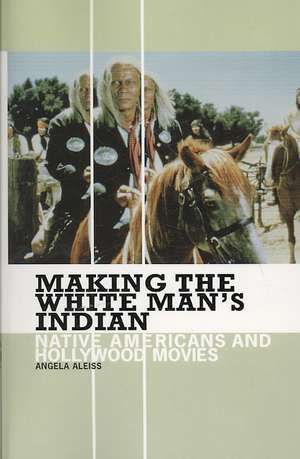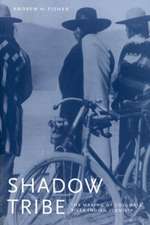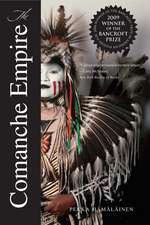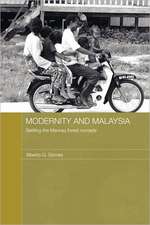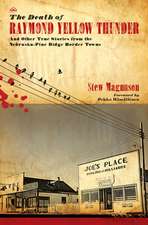Making the White Man's Indian: Native Americans and Hollywood Movies
Autor Angela Aleissen Limba Engleză Paperback – 29 mai 2005 – vârsta până la 17 ani
| Toate formatele și edițiile | Preț | Express |
|---|---|---|
| Paperback (1) | 179.17 lei 43-57 zile | |
| Bloomsbury Publishing – 29 mai 2005 | 179.17 lei 43-57 zile | |
| Hardback (1) | 355.82 lei 43-57 zile | |
| Bloomsbury Publishing – 29 mai 2005 | 355.82 lei 43-57 zile |
Preț: 179.17 lei
Preț vechi: 222.39 lei
-19% Nou
Puncte Express: 269
Preț estimativ în valută:
34.28€ • 35.89$ • 28.54£
34.28€ • 35.89$ • 28.54£
Carte tipărită la comandă
Livrare economică 31 martie-14 aprilie
Preluare comenzi: 021 569.72.76
Specificații
ISBN-13: 9780313361333
ISBN-10: 0313361339
Pagini: 232
Dimensiuni: 156 x 235 x 18 mm
Greutate: 0.36 kg
Editura: Bloomsbury Publishing
Colecția Praeger
Locul publicării:New York, United States
ISBN-10: 0313361339
Pagini: 232
Dimensiuni: 156 x 235 x 18 mm
Greutate: 0.36 kg
Editura: Bloomsbury Publishing
Colecția Praeger
Locul publicării:New York, United States
Notă biografică
Angela Aleiss is a contributing writer for such publications as the Los Angeles Times, Variety, and The Hollywood Reporter. She is a former postdoctoral fellow at the American Indian Studies Center at the University of California, Los Angeles, and a Fulbright Fellow at the University of Toronto.
Cuprins
ForewordPrefaceIntroductionHollywood and the Silent AmericanA Cultural DivisionIndian Adventures and Interracial RomancesWar and Its Indian AlliesRed Becomes WhiteA Shattered IllusionSavagery on the FrontierBeyond the WesternConclusionAppendix A: Motion Pictures ScreenedAppendix B: Motion Picture ArchivesSelected Bibliography
Recenzii
The literature includes dozens of books on the Hollywood Western, and perhaps a dozen just on the representation of Native Americans in Hollywood film..[t]he writing and research are scrupulous and engaging. Highly recommended. Lower-/upper-division undergraduates, graduate students, general readers.
Making the White Man's Indian reminds us that films were made to make money and that they reflected whatever niche Indians occupied in the American attitude toward Indians and minorities at the time the films were made. Professor Aleiss explains why Hollywood representation of Indians has swung back and forth between the Indian-as-savage and the Indian-as-noble and sympathetic. Portraying Indians as people is not new..Hollywood may shape images but it responds in a cultural context. Her reviews of many obscure or forgotten films are a bonus..[b]elongs in the mainstream of current interpretations of Indian representations.
While Aleiss's book is a serious study, it is lively and very readable, full of little-known facts and anecdotes that add interest to its analysis..[M]aking the White Man's Indian is a useful addition for most libraries.
[D]raws on behind-the-scenes material such as correspondence, evolving scripts, studio publicity materials, reactions from film critics and Native American groups, and records of the self-censorship organization, to cast new light on the portrayal of Native Americans in US films.
Making the White Man's Indian reminds us that films were made to make money and that they reflected whatever niche Indians occupied in the American attitude toward Indians and minorities at the time the films were made. Professor Aleiss explains why Hollywood representation of Indians has swung back and forth between the Indian-as-savage and the Indian-as-noble and sympathetic. Portraying Indians as people is not new..Hollywood may shape images but it responds in a cultural context. Her reviews of many obscure or forgotten films are a bonus..[b]elongs in the mainstream of current interpretations of Indian representations.
While Aleiss's book is a serious study, it is lively and very readable, full of little-known facts and anecdotes that add interest to its analysis..[M]aking the White Man's Indian is a useful addition for most libraries.
[D]raws on behind-the-scenes material such as correspondence, evolving scripts, studio publicity materials, reactions from film critics and Native American groups, and records of the self-censorship organization, to cast new light on the portrayal of Native Americans in US films.
